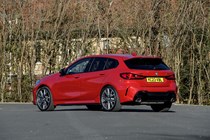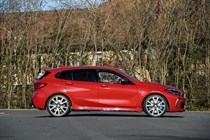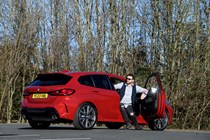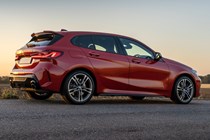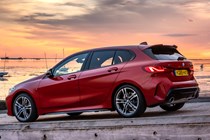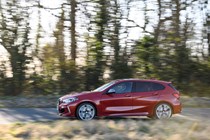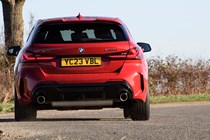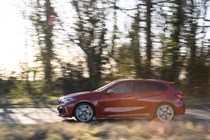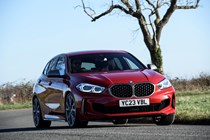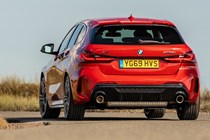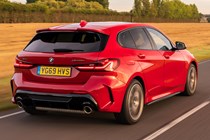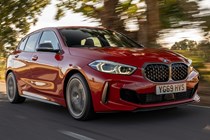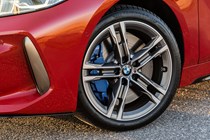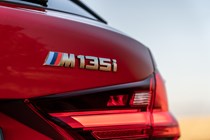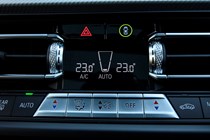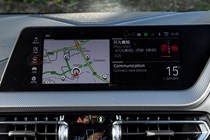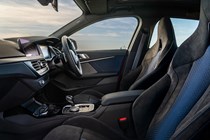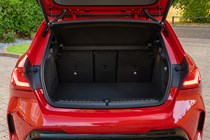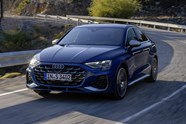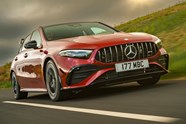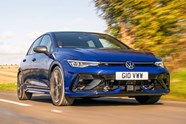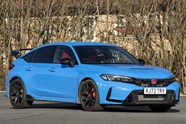
BMW 1-Series M135i (2019-2024) review
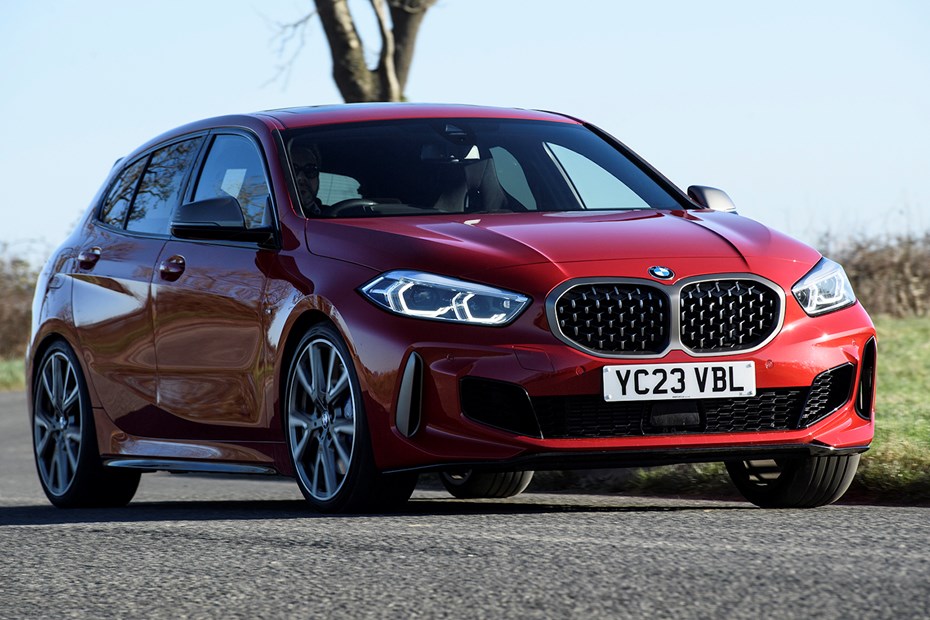
At a glance
| Price new | £38,100 - £44,125 |
|---|---|
| Used prices | £17,200 - £34,870 |
| Road tax cost | £195 - £620 |
| Insurance group | 36 |
Get an insurance quote with

|
|
| Fuel economy | 35.3 - 38.2 mpg |
| Range | 429 miles |
| Miles per pound | 5.2 - 5.6 |
| Number of doors | 5 |
| View full specs for a specific version | |
Available fuel types
Petrol
Pros & cons
- Usable daily performance
- Unshakable handling
- Class-leading interior
- Lacks entertainment
- Uninspiring engine
- Rear passenger space
BMW 1-Series M135i (19-24) rivals
Overview
BMW’s approach to building the most complete hot hatchback on the market has changed over the years. Whether it’s been a four- or six-cylinder challenger that’s rear- or four-wheel drive, the fastest 1 Series has consistently been the best driving car in its class. The M135i is the latest in a line that finds itself up against some very capable cars for a spot at the top of the heap.
The good news is that the M135i lives up to expectations. Now a four-cylinder, turbocharged performance car with all-wheel drive, it goes toe-to-toe with the Audi S3, Mercedes-AMG A35 and Volkswagen Golf R – and manages to distinguish itself with honours. It’s a mechanical configuration that works well enough to enjoy if you just want to go fast, rather than master the art of driving.
When it first arrived, the 2.0-litre M135i felt like it might have have been softened a little too much compared with its predecessors, bordering on bland. A facelift and refresh in 2023 marked a return to form, restoring some of the sharper edge expected from a Bavarian M-badged car – though it would take some serious programming to replace the thrill and potential danger of the old M140i’s big-engine, small-RWD-car recipe.
We’ve driven it over a period of several months, and you can find out more about how we test on Parkers via our dedicated explainer page. But in the meantime, here’s what Richard Kilpatrick found when he tested the car on some of the country’s most demanding roads.
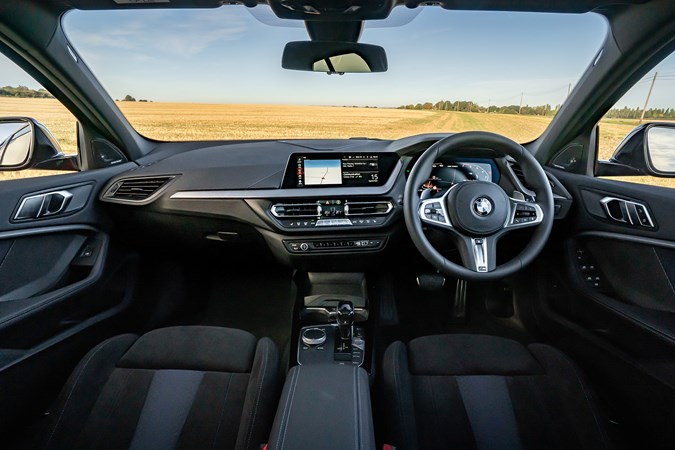
What’s it like inside?
If there’s one area where the BMW 1 Series remains streets ahead of its competition it’s behind the wheel (not that this is a strength particular to the M model). The dashboard is home to many buttons and switches, well-placed and less distracting than the Volkswagen Golf’s touchscreen. Build quality reflects BMW’s reputation for precision engineering as well, and is a level beyond both Audi and Mercedes-AMG rivals.
Not only are the controls easy to identify and reach, the layout is sensibly aimed at the driver and mostly placed in a comfortable eyeline without peering at screens or fumbling in darkness. The ability to turn the air conditioning up and down without taking your eyes off the road shouldn’t be a novelty, yet somehow that’s where car design has gone. Except for BMW, so far.
Overall, there’s a sense that it has been designed to let you concentrate on driving, rather than looking impressive, which is refreshing. There is a caveat to all of this – if you’re not a huge fan of BMW’s interior design then the 1 Series does little to break away from that mould. Inside it looks and feels quite a bit like a current 3 Series and the shapes and layouts aren’t a million miles from BMWs of old.
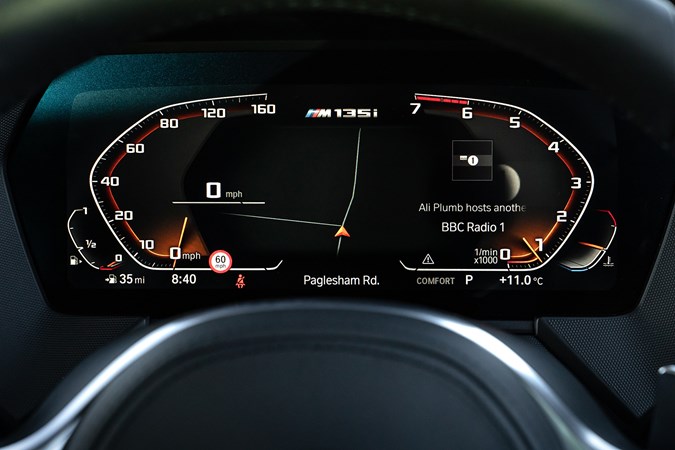
The 10.25-inch main screen is controlled by an iDrive rotary dial (another potential Marmite addition) and however much you like or dislike it, is undeniably easier to use on the move than a touchscreen, though it also supports touch input. The infotainment layout itself does take a bit of getting used to, but the graphics are crisp and colourful.
The 10.25-inch digital dashboard screen is fine but a bit lacking in functionality – only the middle bit can be customised and the speed and rev counter running up the edges aren’t particularly nice to look at.
The connected aspect of the infotainment system is brilliant, though. After a couple of hours playing with BMW’s ConnectedDrive system, it’s easy to see where BMW’s reputation as part of a busy professional lifestyle comes from. The tech experience is so polished that I can ask Alexa in the kitchen to warm up the interior for me, and iDrive can stream Spotify even when I don’t have my phone. It took very little time to set up, ‘just works’, and I’m impressed.
Comfort
Huggy bucket seats in the front can be tailored for differing hip widths thanks to adjustable bolsters, a BMW hallmark, which allow for a bit of give or a precise fit depending on your preference. An extendable thigh cushion and plenty of height adjustment in the seat base caters for a variety of driving positions.
The seats themselves feel quite firm, but if anything, this provides more support on a long journey and keeps back pain at bay. You should have no problem getting comfortable in the front, even if you’re tall.
It’s a different story in the rear though with something of a shortage of headroom. Behind a tall driver you’ll also find your legs pressed into the seatback, although in fairness there is more space here than in the old rear-wheel drive 1 Series.
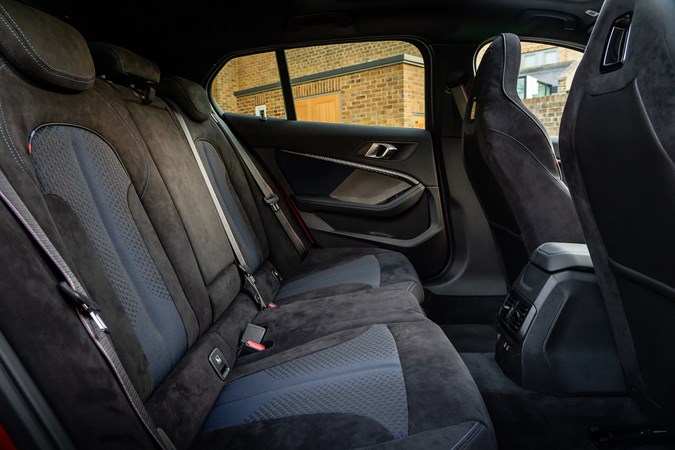
Safety
As with the standard 1 Series you get a five-star Euro NCAP rating and a whole bunch of safety kit. Highlights include lane keeping assist and a reversing camera, but the Driving Assistant package (which includes adaptive cruise control) is not always available to order on the M135i.
What’s it like to drive?
Look, I would love to say the chassis tweaks (new rear suspension mounts, increased front camber, etc) have transformed the character of the BMW M135i, but these are incremental improvements.
The Golf R and the M135i seem to have conspired to swapped roles – where the BMW was once the tail-happy driver’s tool and the VW the tied-down no-surprises rocket ship, now they’re more like the opposite. The Golf R even has drift mode, for goodness’s sake.
There is no denying the speed, with 306hp and a 0-62mph time comfortably under five seconds, the M135i delivers all the real-world pace you need in a very undramatic way. The noise takes on a bit more character in Sport mode with some burbles and bangs from the exhaust but it’s a bit synthetic, with quite a bit coming from the stereo speakers.
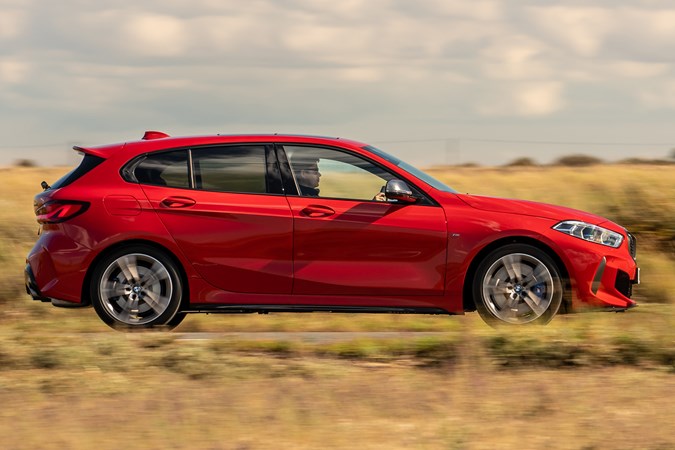
It’s also more than flexible enough so you don’t often feel the need for a much lower gear to make progress, which is good, because the eight-speed automatic gearbox isn’t always the most agile. Manual control spices things up a bit but also introduces a kick to the upshift I’m not sure anyone asked for.
In the handling department the M135i feels very sure-footed and can’t be provoked into anything more entertaining. It’s predominately front-wheel drive and only sends power rearwards if it really needs to. This is not always a bad thing, and in cold, wet weather it can summon up levels of grip comparable with a rock climber’s handshake.
It’s more impressive on a long drive, ironically, which makes the M135i one of the nicer hot hatches to live with. It’s just not very hot. Sorry.
Ownership costs and maintenance
BMW claims 37.2mpg from the M135i, but to get this you’d need to steer clear of enthusiastic driving. That’s not bad for the performance on offer but worth pointing out that I easily beat that in my long-term test.
I covered more than 3,000 miles with gentle road driving, and the BMW app reported I was getting better economy than 46% of other M135i drivers. The best trip was 39.1mpg – but reassuringly, the overall average ended up at more than 31.0mpg, and I did end up with a fair number of short trips while being fond of the ‘Sport’ button.

What models and trims are available?
There’s just the one M135i variation, so how yours ends up being comes down to how you spec it when you’re buying. There are a number of option packs that supplement the fairy basic equipment tally as it comes out of the factory.
The entry-level model gets 18-inch alloy wheels, BMW Live Cockpit Plus with navigation, leather steering wheel and automatic air conditioning. The option packs include a leather interior and what BMW calls a comfort pack, which includes heated steering wheel, electrically-assisted hatchback opening and electrically-heated and powered memory seats.
What else should I know?
The BMW has all the safety and driver-assistance tech you would expect in a small family car of this size. So you get Autonomous Emergency Braking (AEB) and Lane Departure Warning. You can get a fuller breakdown. of the BMW 1 Series’ safety systems, here.
To find out if the BMW M135i is better than its hugely capable rivals, read on for my long-term test and overall verdict.



